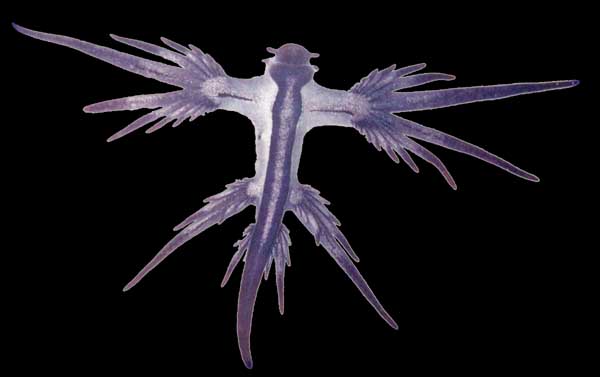This species has been observed on Reunion, Mauritius and Mayotte Islands
Species characteristics : The cerata are arranged in a single row in each arch The foot and undersides of the cerata are blue or blue and white. |

|
|
| Showing species characteristics... | Photo David Caron Reunion, "Hermitage" on the beach, 12 October 2006, size 40 mm Upper view but ventral side... |
|
See more about : Sightening and mating periods
See more about : Important appearance of Glaucus atlanticus at L'ermitage
Remarks :
Identification confirmed by Bill Rudman
Synonymous (according worms) :
- Doris radiata Gmelin, 1791 - Glaucus hexapterigius Cuvier, 1805
- Glaucus distichoicus d'Orbigny, 1837 - Glaucus lineatus Reinhardt & Bergh, 1864
- Glaucus flagellum Blumenblach, 1803 - Glaucus longicirrhus Reinhardt & Bergh, 1864
Bibliographic data :
It has similarities in colour pattern to Glaucus marginatus. The main external difference is that in Glaucus atlanticus the cerata are arranged in a single row in each arch while in Glaucus marginatus there are multiple rows.
Glaucus atlanticus, live in close association with what Sir Alistair Hardy described many years ago as "The Blue Fleet" ( the siphonophores such as Physalia ("Portuguese man-of-war" or "Bluebottle"), Velella, Porpita and the other associated animals including the "Violet snails" of the genus Janthina)
All these animals float on the surface of the ocean being carried by the currents and the winds. Most of us are only aware of their existence when days of onshore winds blow great fleets of them on to the beaches, causing problems for swimmers.
They spend their life floating upside down in the water, partially maintening buoyancy by swallowing an air bubble in their stomachs
They feed almost exclusively on Physalia , and as Tom Thompson and Isabel Bennett reported some years ago, it appears that they are able to select the most venomous of Physalia's stinging nematocysts for their own use. Like most Aeolids, they store the nematocysts in special sacs (cnidosacs) at the tip of their cerata. Glaucus, by concentrating the most venomous of Physalia's nematocysts, are much more deadly.
They exhibit a textbook example of colour countershading. Their foot and undersides of the cerata, (which because they float upside down is effectively their dorsal surface), is blue or blue and white which helps to camouflage them from predation (sea birds) from above. Their true dorsal surface, which faces down in the water, is silvery grey to effectively camouflage them from fish looking up from below.
References :
Bill Rudman Seaslug site : Sea Slug Forum : Glaucus atlanticus
Nudipixel Glaucus atlanticus
Publications :
Bergh, L.S.R. (1884) Report on the Nudibranchiata dredged by H.M.S. Challenger during the years 1873-1876. Report of the Scientific Results of the Voyage of H.M.S. Challenger during the years 1873-76, ... Zoology, 10(26) : 1-154, pls. 1-14. [ Glaucus : p.10-16]
Forster, G. (1777) A voyage round the world in His Britannic Majesty's sloop, Resolution, commanded by Capt. James Cook, during the years 1772, 3, 4, and 5 by George Forster. Vol 1 : p49.
Thompson, T.E. & McFarlane, I.D., 1967. Observations on a collection of Glaucus from the Gulf of Aden with a critical review of published records of Glaucidae (Opisthobranchia). Proceedings of of the Linnean Society, 178 : 10-123.
Thompson,TE. & Bennett,I., 1969. Physalia nematocysts: Utilised by mollusks for defense. Science, 166 : 1532-1533.
Thompson,TE. & Bennett,I., 1970. Observations on Australian Glaucidae (Mollusca: Opisthobranchia). Zoological Journal of the Linnean Society, 49 : 187-197.
Other photos of Glaucus atlanticus :
Maurice Jay Reunion, Floating on the surface of the ocean |
 |
 |
Armand Daydé Mayotte, 2006, size : 25 mm
|
More photos from Indian Ocean
See more about : Important appearance of Glaucus atlanticus at l'ermitage
Reunion, a very small Glaucus atlanticus, at Saint Gilles, by Guillaume Nedellec
Reunion, Glaucus atlanticus found drifting in the ocean, at Saint Leu, by Claire Jean
Mauritius, Glaucus atlanticus, at Pointe d'Esny, by Geoffrey Summers